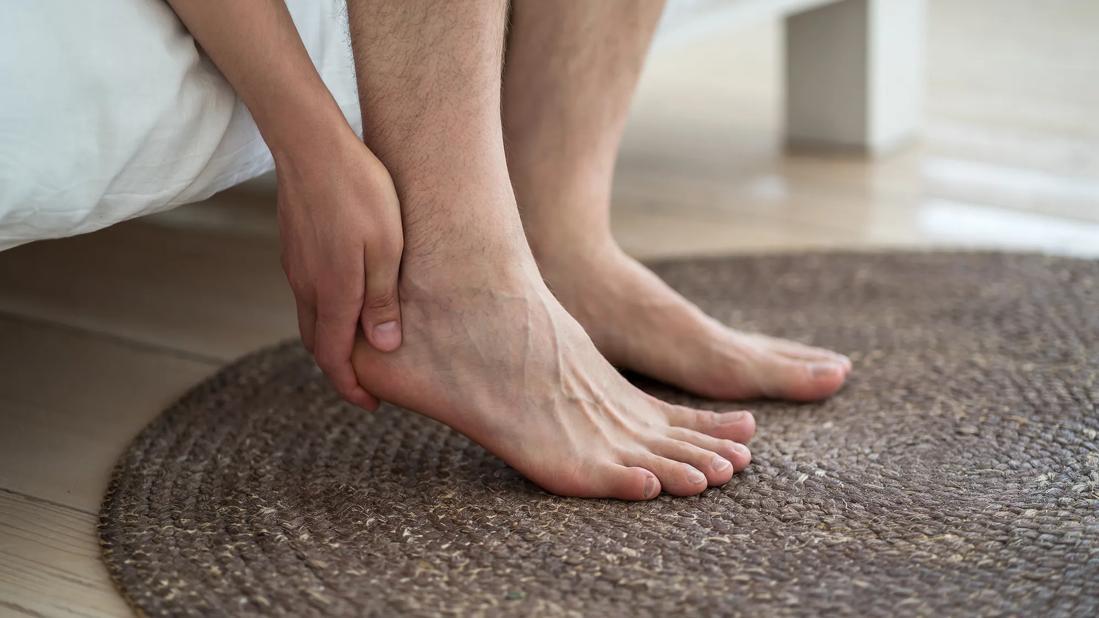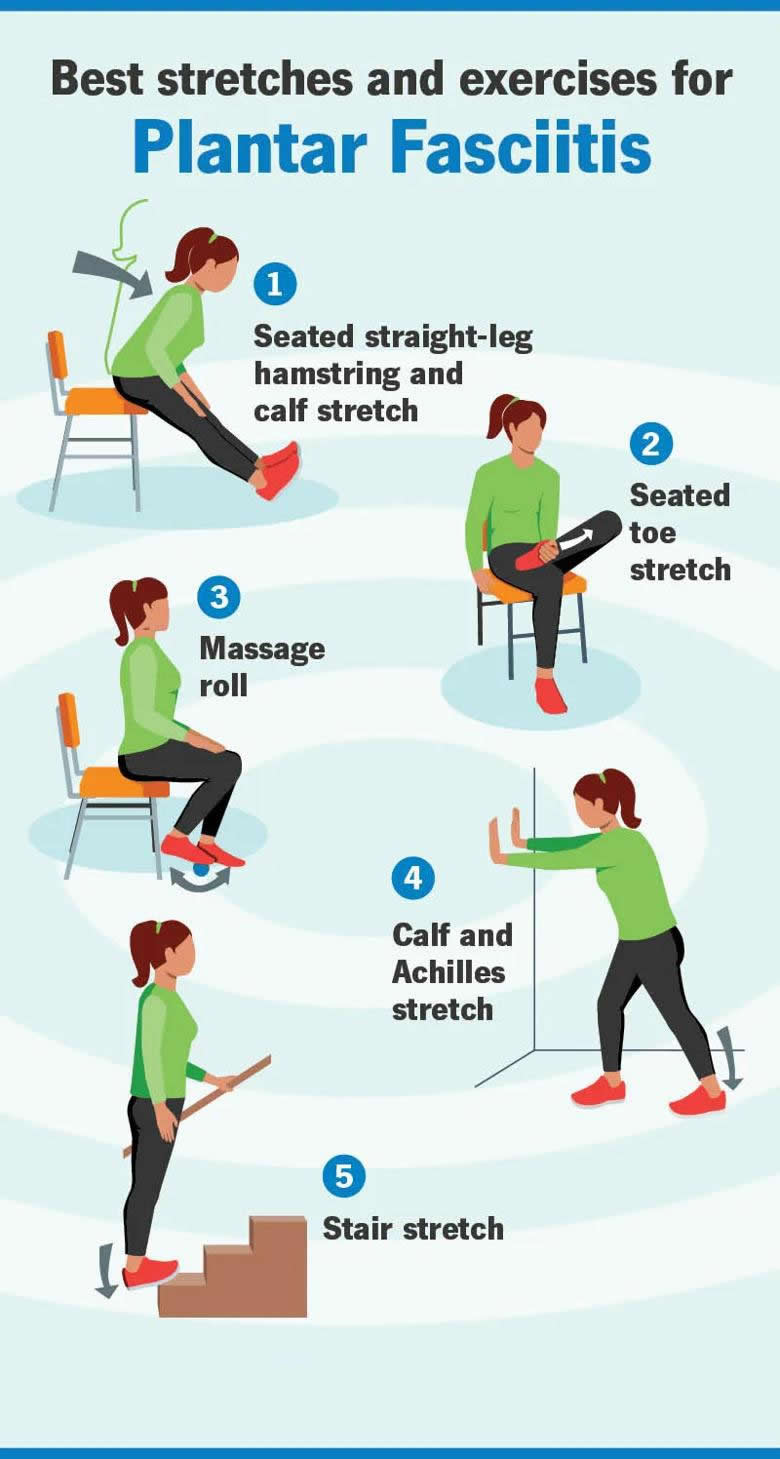Plantar Fasciitis Stretches and Exercises
Try seated and standing exercises to help lengthen and strengthen the muscles that support your plantar fascia

Plantar fasciitis can be a real pain in the kicker.
With plantar fasciitis, you can over-stress the thick band of tissue that runs from your heel to your toe on the bottom of your foot (plantar fascia) — either from being on your feet all day or from over-use and exercise. When this happens, it can get in the way of almost anything.
Fortunately, podiatrist Samantha Figas, DPM, recommends a number of stretches and exercises that you can do at home to help relieve some of that tension.
Best stretches and exercises for plantar fasciitis
There are several stretches and exercises you can use during your daily routine to help relieve plantar fasciitis, alongside other treatments, like NSAIDs and rest.
“Stretching is the most important treatment for plantar fasciitis because it helps make the tissues more flexible, lowers tension and eases pain,” says Dr. Figas.
Many people with plantar fasciitis also have tight calf muscles. Calf muscles connect to your Achilles tendon, which wraps around your heel and connects with the plantar fascia at the bottom of your foot. This means a tight calf can make your plantar fascia tight, too.
Dr. Figas recommends stretching for at least 10 minutes a day when treating plantar fasciitis. It can take several months for the pain to fully go away and it could come back. So, it’s important to keep stretching even after you feel better.
Here are five plantar fasciitis stretches and exercises to try.

1. Seated straight-leg hamstring and calf stretch
This stretch helps loosen tight muscles and stretch the connective tissue in your back and legs to better support your feet.
- While seated, extend both legs out in front of you, keeping your knees straight and heels on the floor. Make sure your feet and toes are pointed up and not to the side.
- Slowly lean forward while keeping your back straight. Stop when you feel a gentle stretch in your back and hamstrings (the back of your legs).
- Hold this stretch for three to five breaths.
- If you have difficulty leaning forward, you can place a towel around one extended foot and gently pull the towel toward you until you feel a stretch in your calf. Hold this position for three to five breaths before repeating it with the opposite foot.
2. Seated toe stretch
For a deeper stretch focused on your plantar fascia, try the following:
- While seated, cross your legs and place your right ankle on your left knee.
- With your left hand, gently pull back the toes on your right foot toward your right leg until you feel a stretch in the arch of your foot.
- Hold this stretch for three to five breaths.
- Relax and then repeat two to three times.
- Repeat this process for your left foot.
3. Massage roll
Try this massage to relieve muscle tension in your feet while sitting at your desk or kitchen table. It can be done a few times a day. You’ll need a rollable object, like a frozen water bottle, golf ball or tennis ball. A frozen water bottle specifically can also help treat inflammation associated with plantar fasciitis.
- Start in a seated position on a chair, with your feet flat on the floor.
- Place your rollable object under one foot. Roll your foot back and forth over it, applying gentle pressure from heel to toe.
- Continue this back-and-forth motion for two to three minutes, then repeat on the other foot.
4. Calf and Achilles stretch
This deep stretch focuses on the back of your legs.
- Stand tall with your feet hip-width apart and pointed forward.
- Extend your right leg behind you while gently bending your left knee (like a reverse lunge). Keep your feet parallel. You can lean into a wall with your arms to balance yourself.
- While keeping your right leg straight, gently lower your right heel until it’s flat on the floor. Keep your back foot and toes pointed straight ahead.
- You can gauge the depth of the stretch by how deeply you bend your front knee. If you have trouble putting your heel on the floor, shorten the length of your lunge.
- Hold this stretch for three to five breaths and then repeat on the opposite side.
5. Stair stretch
This stretch helps relieve tension in your calf and Achilles tendon, which helps relieve some of the pain associated with plantar fasciitis.
- While holding onto a railing or wall for stability, stand on a bottom step with your heels hanging off the edge.
- Drop one heel down, while keeping the ball of your foot on the step. You’ll feel a stretch in the back of your calf and Achilles tendon.
- Hold this stretch for three to five breaths and then repeat on the opposite side.
One step at a time
Remember, it’s important to follow your healthcare provider’s recommendations for treating plantar fasciitis. But if you’ve dealt with this sort of pain before, or if you’re planning to go on a long walk or hike where your feet may be further affected, these stretches and exercises can help prevent or reduce plantar fasciitis pain in the future.
“Plantar fasciitis is considered an overuse injury. You’ll often have to modify your activities in order to allow this condition to heal,” notes Dr. Figas.
“Avoiding high-impact activities like running, jumping or jogging can help with healing. You can also continue low-impact activities like walking, biking or swimming, as long as this doesn’t aggravate your symptoms.”